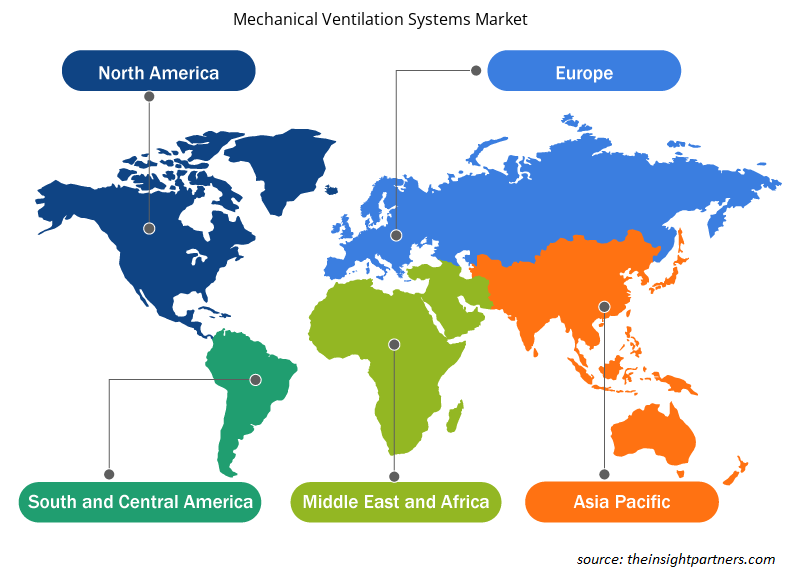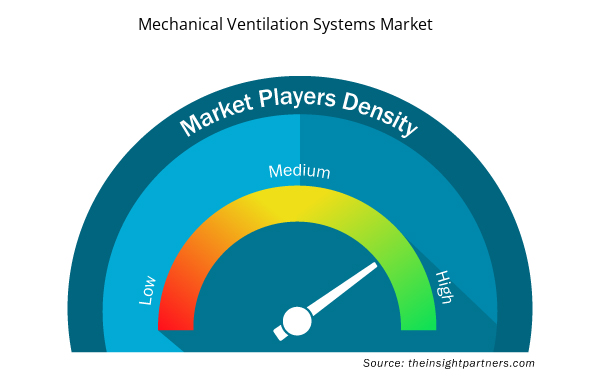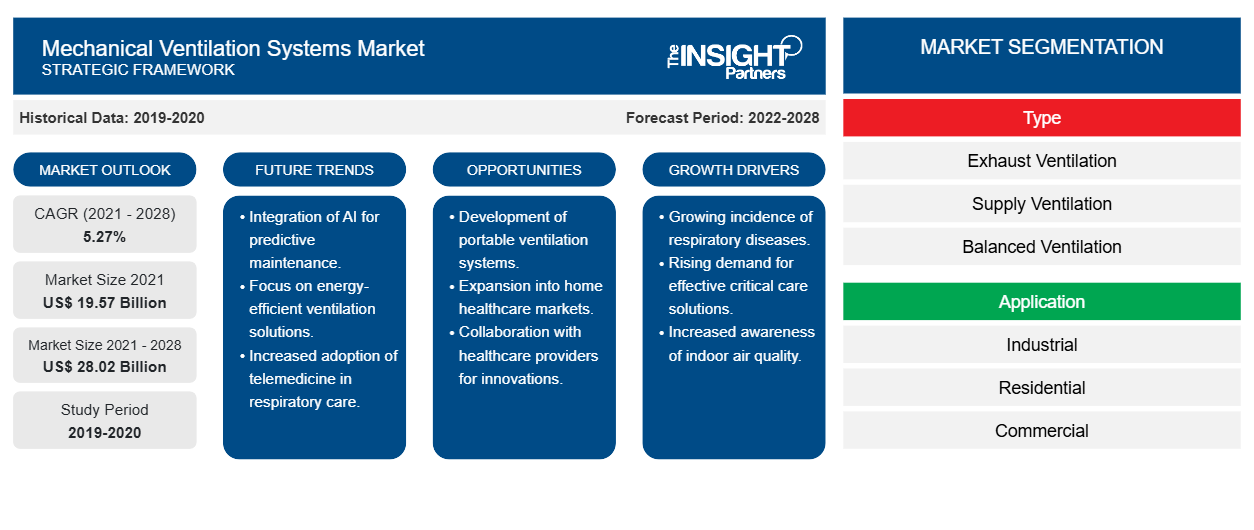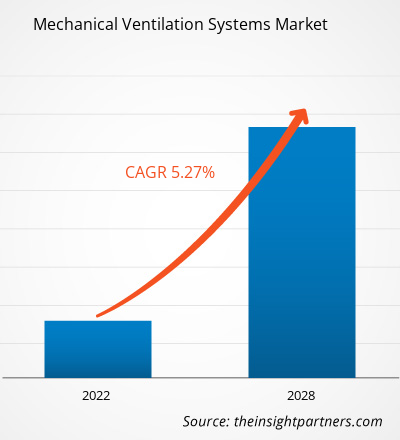Der Markt für mechanische Belüftungssysteme soll von 19.566,67 Millionen US-Dollar im Jahr 2021 auf 28.022,63 Millionen US-Dollar im Jahr 2028 wachsen; von 2021 bis 2028 wird mit einer durchschnittlichen jährlichen Wachstumsrate von 5,27 % gerechnet.
Mechanische Belüftung ist ein System, das verunreinigte Innenluft entfernt und frische Außenluft zugeführt wird, um in Wohn-, Geschäfts- und Industriebereichen eine gesunde und sichere Arbeitsumgebung zu schaffen. Ein mechanisches Belüftungssystem besteht aus zwei Hauptkomponenten – einem Frischluftzufuhrsystem und einem Abluftsystem. Das Zuluftsystem umfasst einen Lufteinlass, eine Luftfilteranlage und eine Klimaanlage. Mechanische Belüftungssysteme sind so konzipiert, dass sie Außenluft mit einer bestimmten Geschwindigkeit einführen, die der Art der Arbeit und der Menge der in einem Gebäude oder Arbeitsplatz freigesetzten Schadstoffe entspricht. Mechanische Belüftung wird bevorzugt, um die Belastung der Mitarbeiter durch Luftschadstoffe zu kontrollieren. Weitere Vorteile der mechanischen Belüftung sind die Aufrechterhaltung einer angenehmen Temperatur und Luftfeuchtigkeit sowie die Verringerung potenzieller Brand- oder Explosionsgefahren. In Wohngebäuden verwendet das Ganzhausbelüftungssystem Ventilatoren, um die Luftqualität zu verbessern, indem die Menge der Luftschadstoffe reduziert und die Luftfeuchtigkeit im Haus reguliert wird.
Passen Sie diesen Bericht Ihren Anforderungen an
Sie erhalten kostenlos individuelle Anpassungen an jedem Bericht, einschließlich Teilen dieses Berichts oder einer Analyse auf Länderebene, eines Excel-Datenpakets sowie tolle Angebote und Rabatte für Start-ups und Universitäten.
- Holen Sie sich die wichtigsten Markttrends aus diesem Bericht.Dieses KOSTENLOSE Beispiel umfasst eine Datenanalyse von Markttrends bis hin zu Schätzungen und Prognosen.
Auswirkungen der COVID-19-Pandemie auf den Markt für mechanische Lüftungssysteme
Der COVID-19-Ausbruch hat die Weltwirtschaft durch die umfassenden Lockdowns, die die Menschen dazu zwangen, zu Hause zu bleiben, erheblich beeinträchtigt. Die Pandemie hat die Bau- und Fertigungsaktivitäten in vielen Regionen behindert, da die Verfügbarkeit von Arbeitskräften und die Versorgung mit Ausrüstung drastisch reduziert sind, was wiederum das Wachstum des Marktes für mechanische Lüftungssysteme behindert . Einige führende Anbieter des Marktes für mechanische Lüftungssysteme wie Mitsubishi Electric Corporation, Airflow Developments Limited und Infineon Technologies AG tragen jedoch erheblich zum Marktwachstum bei, indem sie strategische Kooperationen eingehen, neue Produkte auf den Markt bringen und den technologischen Fortschritt finanzieren. Lüftungssysteme helfen, luftgetragene Schadstoffe wie Viren in einem Gebäude oder kleinen Raum zu reduzieren. Das Design eines Gebäudes, die Belegung und die Art der HLK-Systeme können die Verbreitung potenzieller luftgetragener Viren und Bakterien kontrollieren. Außerdem wird erwartet, dass Modifikationen an HLK-Systemen dazu beitragen, die Verbreitung des neuartigen Coronavirus, das COVID-19 verursacht, durch Reinigung und Steuerung der Luftströme zu verringern. Die Umweltschutzbehörde empfiehlt Belüftung und Luftfilterung als wichtige Komponenten, um das Risiko der Übertragung schädlicher Luftschadstoffe auszuschließen. Es wird erwartet, dass solche Initiativen das Wachstum des Marktes für mechanische Belüftungssysteme in der Zeit nach der COVID-19-Pandemie ankurbeln werden.
Markteinblicke in mechanische Belüftungssysteme
Steigende Nachfrage nach Smart Cities weltweit
Das Wachstum von Smart Cities und Green Building-Initiativen auf der ganzen Welt treibt den Markt für mechanische Belüftungssysteme an. Strenge staatliche Vorschriften zur Reduzierung des Energieverbrauchs und erhöhte Anforderungen an nachhaltige Bauoptionen haben zum Bau von grünen Gebäuden geführt. Die zunehmende Betonung der Innenraumqualität (IEQ) in grünen Gebäuden führt zu einer Zunahme der Installationen mechanischer Belüftungssysteme. Unter den Bauherren von grünen Gebäuden besteht eine wachsende Nachfrage nach Energierückgewinnungslüftung, Ganzhausventilatoren und energiesparenden Abluftventilatoren, um Belüftung, Feuchtigkeitskontrolle und lokale Abluft, Zuluftfilterung, Radonschutz und Schadstoffkontrolle zu gewährleisten. Länder wie die USA, Kanada, Südkorea, Schweden, Taiwan, Japan, Schottland und Singapur verfolgen aktiv eine Smart City-Strategie. Die Ryerson University in Toronto, Kanada, untersucht die wirtschaftlichen Auswirkungen mechanischer Belüftung in Gebäuden, um Kohlenstoffemissionen auszugleichen und sie CO2-neutral zu machen.
Die indische Regierung startete 2015 die National Smart Cities Mission mit dem Ziel, Städte durch den Einsatz intelligenter Technologien bürgerfreundlicher und nachhaltiger zu machen. Das Indian Green Building Council (IGBC) zertifizierte grüne Gebäude mit intelligenten Belüftungssystemen, die im Vergleich zu konventionellen Gebäuden Energieeinsparungen von 40–50 % ermöglichen. Die Europäische Kommission finanziert die Smart Cities-Projekte über das Forschungs- und Innovationsprogramm Horizont 2020. Das Smart City-Programm von Dublin ermöglicht es regionalen Behörden, mit Anbietern intelligenter Technologien zusammenzuarbeiten, um das Leben in der Stadt zu verbessern. In ähnlicher Weise wandelt sich Singapur zu einer „Smart Nation“, indem es energieeffiziente Technologien zur Verbesserung des Lebens und zur Schaffung wirtschaftlicher Möglichkeiten nutzt. Laut dem US Green Building Council (USGBC) können grüne Gebäude mit unterstützenden mechanischen und Energieventilatoren zu einer Wertsteigerung von 10 % führen. Solche Initiativen haben den Bau weiterer „grüner Gebäude“ gefördert und in der Folge die Nachfrage nach mechanischen Belüftungssystemen erhöht, was das Marktwachstum erheblich vorantreibt.
Anwendungsbasierte Markteinblicke
Nach Anwendung ist der Markt für mechanische Belüftungssysteme in Industrie, Wohnbereich und Gewerbe unterteilt. Die industriellen Belüftungssysteme bestehen aus zwei zentralen Komponenten – Frischluftzufuhrsystem und Abluftsystem. Das Zuluftsystem besteht aus Komponenten wie Lufteinlass, Luftfilterausrüstung, Kanalsystemen, Ventilatoren, Heiz- und Kühlausrüstung und Luftverteilungsregistern. Es gibt zwei Arten von Belüftungssystemen für industrielle Anwendungen, nämlich Verdünnungsbelüftung und lokale Abluftsysteme. Die industrielle Umgebung umfasst künstliche Wärme- und Kälteumgebungen innerhalb einer Anlage. Sie umfasst auch die Arbeiter und Angestellten des Unternehmens innerhalb der Industrieanlage. In einer solchen Umgebung wird die Sicherheit der Mitarbeiter zu einem wichtigen Faktor für alle Industriellen. Angesichts der Bedenken hinsichtlich der Gesundheit und Sicherheit der Angestellten und Arbeiter werden daher Belüftungssysteme installiert, um eine gesündere Umgebung innerhalb einer Industrieanlage aufrechtzuerhalten. Dies ist einer der Hauptfaktoren, die das Wachstum des Marktes für mechanische Belüftungssysteme für das Industriesegment vorantreiben.
Akteure auf dem Markt für mechanische Lüftungssysteme verfolgen Strategien wie Fusionen, Übernahmen und Marktinitiativen, um ihre Position auf dem Markt zu behaupten. Nachfolgend sind einige Entwicklungen der wichtigsten Akteure aufgeführt:
- Im Juli 2021 wurde DUCO als Anbieter innovativer und hochwertiger Lösungen identifiziert, die dem Endverbraucher ein gesundes Raumklima gewährleisten. Dies wird durch das umfangreiche Sortiment des Unternehmens an Fensterlüftern und -kästen, Lamellengittern und Sonnenschutzgeweben erreicht. Für die internationale Expansion arbeitet das Unternehmen mit Daikin Europe, einem Hersteller von HVAC-Bauprodukten, zusammen.
- Im September 2021 wurde Energy Recovery Industries, ein bedeutender Hersteller und Anbieter von kohlenstoffarmen, energieeffizienten Wärmetauscherzellen, von der Volution Group Plc übernommen. Auf schuldenfreier, bargeldfreier Basis betrug der anfängliche Kaufpreis 27,2 Millionen US-Dollar, mit einer bedingten Barzahlung von bis zu 14,4 Millionen US-Dollar, abhängig von der Erfüllung der Erwartungen hinsichtlich der Finanzergebnisse für das am 31. Dezember 2023 endende Geschäftsjahr.exchanger cells, was acquired by Volution Group Plc. On a debt-free cash-free basis, the initial consideration for the acquisition was US$ 27.2 million, with a contingent cash payment of up to US$ 14.4 million based on achieving expectations for the financial results for the year ending December 31, 2023.
Regionale Einblicke in den Markt für mechanische Lüftungssysteme
Die regionalen Trends und Faktoren, die den Markt für mechanische Lüftungssysteme im Prognosezeitraum beeinflussen, wurden von den Analysten von Insight Partners ausführlich erläutert. In diesem Abschnitt werden auch die Marktsegmente und die Geografie für mechanische Lüftungssysteme in Nordamerika, Europa, im asiatisch-pazifischen Raum, im Nahen Osten und Afrika sowie in Süd- und Mittelamerika erörtert.

- Erhalten Sie regionale Daten zum Markt für mechanische Lüftungssysteme
Umfang des Marktberichts über mechanische Lüftungssysteme
| Berichtsattribut | Details |
|---|---|
| Marktgröße im Jahr 2021 | 19,57 Milliarden US-Dollar |
| Marktgröße bis 2028 | 28,02 Milliarden US-Dollar |
| Globale CAGR (2021 - 2028) | 5,27 % |
| Historische Daten | 2019-2020 |
| Prognosezeitraum | 2022–2028 |
| Abgedeckte Segmente | Nach Typ
|
| Abgedeckte Regionen und Länder | Nordamerika
|
| Marktführer und wichtige Unternehmensprofile |
|
Marktteilnehmerdichte: Der Einfluss auf die Geschäftsdynamik
Der Markt für mechanische Lüftungssysteme wächst rasant, angetrieben durch die steigende Nachfrage der Endnutzer aufgrund von Faktoren wie sich entwickelnden Verbraucherpräferenzen, technologischen Fortschritten und einem größeren Bewusstsein für die Vorteile des Produkts. Mit steigender Nachfrage erweitern Unternehmen ihr Angebot, entwickeln Innovationen, um die Bedürfnisse der Verbraucher zu erfüllen, und nutzen neue Trends, was das Marktwachstum weiter ankurbelt.
Die Marktteilnehmerdichte bezieht sich auf die Verteilung der Firmen oder Unternehmen, die in einem bestimmten Markt oder einer bestimmten Branche tätig sind. Sie gibt an, wie viele Wettbewerber (Marktteilnehmer) in einem bestimmten Marktraum im Verhältnis zu seiner Größe oder seinem gesamten Marktwert präsent sind.
Die wichtigsten auf dem Markt für mechanische Belüftungssysteme tätigen Unternehmen sind:
- Volution Group Ltd.
- Aremec
- Mechanische Luftversorgungen GmbH
- Duco Lüftung und Sonnenschutz
- Caladair International
Haftungsausschluss : Die oben aufgeführten Unternehmen sind nicht in einer bestimmten Reihenfolge aufgeführt.

- Überblick über die wichtigsten Akteure auf dem Markt für mechanische Lüftungssysteme
Der globale Markt für mechanische Lüftungssysteme wurde wie folgt segmentiert:
Markt für mechanische Lüftungssysteme – nach Typ
- Abluftventilation
- Belüftungsversorgung
- Ausgewogene Belüftung
- Lüftung mit Energierückgewinnung
Markt für mechanische Lüftungssysteme – nach Anwendung
- Industrie
- Wohnen
- Kommerziell
Markt für mechanische Lüftungssysteme – nach Geografie
Nordamerika
- UNS
- Kanada
- Mexiko
Europa
- Deutschland
- Frankreich
- Italien
- Vereinigtes Königreich
- Russland
- Restliches Europa
Asien-Pazifik (APAC)
- Australien
- China
- Indien
- Japan
- Südkorea
- Restlicher Asien-Pazifik-Raum
Naher Osten und Afrika (MEA)
- Südafrika
- Saudi-Arabien
- Vereinigte Arabische Emirate
- Rest von MEA
Südamerika (SAM)
- Brasilien
- Argentinien
- Rest von SAM
Firmenprofile
- Volution Group plc
- DUCO Lüftung & Sonnenschutz
- Caladair International
- Mitsubishi Electric Corporation
- Airflow Developments Limited
- Wirbel
- BLAUBERG
- INFINEON TECHNOLOGIES AG
- AERMEC (Großbritannien)
- MECHANICAL AIR SUPPLIES LTD
- Historische Analyse (2 Jahre), Basisjahr, Prognose (7 Jahre) mit CAGR
- PEST- und SWOT-Analyse
- Marktgröße Wert/Volumen – Global, Regional, Land
- Branche und Wettbewerbsumfeld
- Excel-Datensatz


- Enzymatic DNA Synthesis Market
- HVAC Sensors Market
- Occupational Health Market
- Machine Condition Monitoring Market
- Digital Pathology Market
- Sterilization Services Market
- Small Internal Combustion Engine Market
- Fixed-Base Operator Market
- Biopharmaceutical Contract Manufacturing Market
- Gas Engine Market

Report Coverage
Revenue forecast, Company Analysis, Industry landscape, Growth factors, and Trends

Segment Covered
This text is related
to segments covered.

Regional Scope
North America, Europe, Asia Pacific, Middle East & Africa, South & Central America

Country Scope
This text is related
to country scope.
Häufig gestellte Fragen
Asia Pacific dominated the mechanical ventilation systems market in 2020 with a share of 35.6% and is expected to continue its dominance by 2028. North America is the second-largest contributor to the global mechanical ventilation systems market in 2020, followed by Europe.
The major companies in mechanical ventilation systems market are Volution Group Ltd.; Aremec; Mechanical Air Supplies Ltd; Duco Ventilation and Sun Control; Caladair International; Mitsubishi Electric Corporation; Airflow Developments Limited; Vortice; Blauberg; and Infineon Technologies AG.
The major applications of mechanical ventilation systems includes industrial, residential, and commercial. In terms of market share, the market was dominated by the commercial segment in 2020.
Based on type, the global mechanical ventilation systems market is segmented into exhaust ventilation, supply ventilation, balanced ventilation, and energy recovery ventilation. The mechanical ventilation systems market was dominated by the exhaust ventilation segment in 2020.
Growing innovations in energy recovery ventilation is anticipated to provide lucrative growth opportunities for the global mechanical ventilation system market. Prominent players are increasingly investing in the design and development of controlled ventilation that transfers heat from the warm exhaust air to the cold supply air to minimize energy and cost of heating ventilated air. A few energy recovery systems also use existing ductwork to manage the expenses. Efficient ducts can effectively reduce pressure drops in the system and improve overall performance. The incorporation of embedded devices in energy recovery systems prevent it from freezing and reduce frost formation that can damage heat exchangers. This further decreases the maintenance costs. Increased focus on indoor climate have increased demand for turn-key heating, ventilation, and air conditioning (HVAC) solutions and integrated cooling methodologies. This is enabling the market vendors to invest in technologies that helps to obtain good thermal comfort and indoor air quality in warm summer seasons.
Growth in smart cities and green building initiatives across the world is driving the mechanical ventilation system market. Stringent government regulations to reduce energy consumption and increased demands for sustainable building options has led to the construction of green buildings. Growing emphasis on indoor environmental quality (IEQ) in green buildings is increasing the installations of mechanical ventilation systems. There is a growing demand for the use of energy recovery ventilation, whole-house fans, and energy-saving exhaust fans among the green building builders to address ventilation, moisture control, and local exhaust, supply air filtration, radon protection, and contaminant control. Countries such as the US, Canada, South Korea, Sweden, Taiwan, Japan, Scotland, and Singapore are actively pursuing a smart city strategy. Ryerson University in Toronto, Canada, is studying the economic impact of mechanical ventilation in buildings, offsetting carbon emissions and making them carbon neutral.
Trends and growth analysis reports related to Electronics and Semiconductor : READ MORE..
The List of Companies - Mechanical Ventilation Systems Market
- Volution Group Ltd.
- Aremec
- Mechanical Air Supplies Ltd
- Duco Ventilation and Sun Control
- Caladair International
- Mitsubishi Electric Corporation
- Airflow Developments Limited
- Vortice
- Blauberg
- Infineon Technologies AG
The Insight Partners performs research in 4 major stages: Data Collection & Secondary Research, Primary Research, Data Analysis and Data Triangulation & Final Review.
- Data Collection and Secondary Research:
As a market research and consulting firm operating from a decade, we have published and advised several client across the globe. First step for any study will start with an assessment of currently available data and insights from existing reports. Further, historical and current market information is collected from Investor Presentations, Annual Reports, SEC Filings, etc., and other information related to company’s performance and market positioning are gathered from Paid Databases (Factiva, Hoovers, and Reuters) and various other publications available in public domain.
Several associations trade associates, technical forums, institutes, societies and organization are accessed to gain technical as well as market related insights through their publications such as research papers, blogs and press releases related to the studies are referred to get cues about the market. Further, white papers, journals, magazines, and other news articles published in last 3 years are scrutinized and analyzed to understand the current market trends.
- Primary Research:
The primarily interview analysis comprise of data obtained from industry participants interview and answers to survey questions gathered by in-house primary team.
For primary research, interviews are conducted with industry experts/CEOs/Marketing Managers/VPs/Subject Matter Experts from both demand and supply side to get a 360-degree view of the market. The primary team conducts several interviews based on the complexity of the markets to understand the various market trends and dynamics which makes research more credible and precise.
A typical research interview fulfils the following functions:
- Provides first-hand information on the market size, market trends, growth trends, competitive landscape, and outlook
- Validates and strengthens in-house secondary research findings
- Develops the analysis team’s expertise and market understanding
Primary research involves email interactions and telephone interviews for each market, category, segment, and sub-segment across geographies. The participants who typically take part in such a process include, but are not limited to:
- Industry participants: VPs, business development managers, market intelligence managers and national sales managers
- Outside experts: Valuation experts, research analysts and key opinion leaders specializing in the electronics and semiconductor industry.
Below is the breakup of our primary respondents by company, designation, and region:

Once we receive the confirmation from primary research sources or primary respondents, we finalize the base year market estimation and forecast the data as per the macroeconomic and microeconomic factors assessed during data collection.
- Data Analysis:
Once data is validated through both secondary as well as primary respondents, we finalize the market estimations by hypothesis formulation and factor analysis at regional and country level.
- Macro-Economic Factor Analysis:
We analyse macroeconomic indicators such the gross domestic product (GDP), increase in the demand for goods and services across industries, technological advancement, regional economic growth, governmental policies, the influence of COVID-19, PEST analysis, and other aspects. This analysis aids in setting benchmarks for various nations/regions and approximating market splits. Additionally, the general trend of the aforementioned components aid in determining the market's development possibilities.
- Country Level Data:
Various factors that are especially aligned to the country are taken into account to determine the market size for a certain area and country, including the presence of vendors, such as headquarters and offices, the country's GDP, demand patterns, and industry growth. To comprehend the market dynamics for the nation, a number of growth variables, inhibitors, application areas, and current market trends are researched. The aforementioned elements aid in determining the country's overall market's growth potential.
- Company Profile:
The “Table of Contents” is formulated by listing and analyzing more than 25 - 30 companies operating in the market ecosystem across geographies. However, we profile only 10 companies as a standard practice in our syndicate reports. These 10 companies comprise leading, emerging, and regional players. Nonetheless, our analysis is not restricted to the 10 listed companies, we also analyze other companies present in the market to develop a holistic view and understand the prevailing trends. The “Company Profiles” section in the report covers key facts, business description, products & services, financial information, SWOT analysis, and key developments. The financial information presented is extracted from the annual reports and official documents of the publicly listed companies. Upon collecting the information for the sections of respective companies, we verify them via various primary sources and then compile the data in respective company profiles. The company level information helps us in deriving the base number as well as in forecasting the market size.
- Developing Base Number:
Aggregation of sales statistics (2020-2022) and macro-economic factor, and other secondary and primary research insights are utilized to arrive at base number and related market shares for 2022. The data gaps are identified in this step and relevant market data is analyzed, collected from paid primary interviews or databases. On finalizing the base year market size, forecasts are developed on the basis of macro-economic, industry and market growth factors and company level analysis.
- Data Triangulation and Final Review:
The market findings and base year market size calculations are validated from supply as well as demand side. Demand side validations are based on macro-economic factor analysis and benchmarks for respective regions and countries. In case of supply side validations, revenues of major companies are estimated (in case not available) based on industry benchmark, approximate number of employees, product portfolio, and primary interviews revenues are gathered. Further revenue from target product/service segment is assessed to avoid overshooting of market statistics. In case of heavy deviations between supply and demand side values, all thes steps are repeated to achieve synchronization.
We follow an iterative model, wherein we share our research findings with Subject Matter Experts (SME’s) and Key Opinion Leaders (KOLs) until consensus view of the market is not formulated – this model negates any drastic deviation in the opinions of experts. Only validated and universally acceptable research findings are quoted in our reports.
We have important check points that we use to validate our research findings – which we call – data triangulation, where we validate the information, we generate from secondary sources with primary interviews and then we re-validate with our internal data bases and Subject matter experts. This comprehensive model enables us to deliver high quality, reliable data in shortest possible time.


 Holen Sie sich ein kostenloses Muster für diesen Bericht
Holen Sie sich ein kostenloses Muster für diesen Bericht